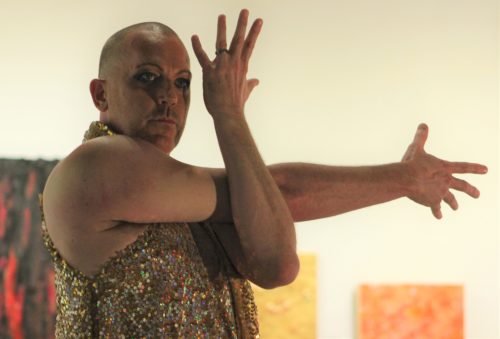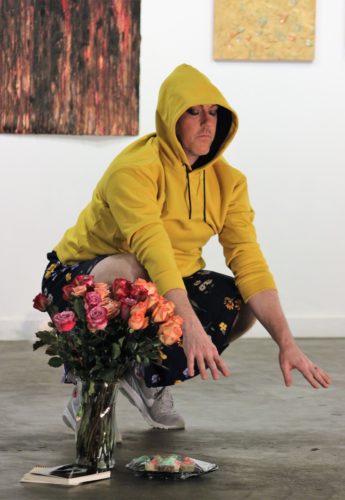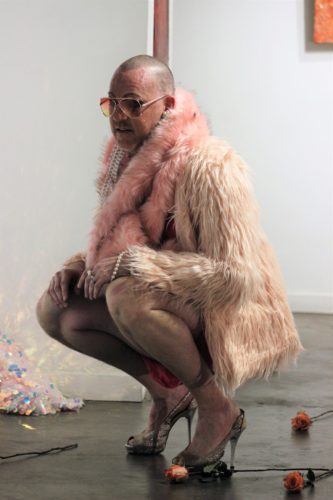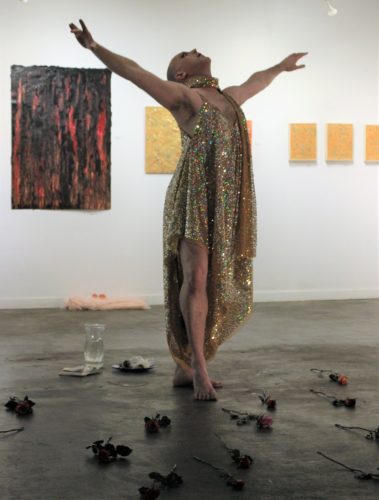“I Don’t Know Who This Is For”: In the loosening grip, jhon r. stronks explores gender performance

All photos by John Slaby
As a biracial, queer, nonbinary writer and artist, I always ask a person upon first introduction what pronouns they use. Although I’d met dancer/choreographer jhon r. stronks before, we’d never spoken at any length in person. Over email I asked Stronks what pronouns to use in this review (among other questions), but to this question, they didn’t respond. When I approached Stronks in person at the end of the loosening grip, a solo performance presented at Archway Gallery in conversation with visual artist Donna E. Perkins’s exhibit SPILL, I was perplexed by the answer he gave: “The idea of using different pronouns is very new for me, so I’m not sure. How about you use the pronoun you see me as? I always learn about myself from being in dialogue with others.” Given his answer, surrounded with ambivalence, it seemed even more fitting Stronks would frame their performance with an epigraph by gender nonconforming artist Alok Vaid-Menon in which they state unequivocally, “I don’t know what my gender is. I don’t know where I’m from. What happened to me ten years ago. But what I do know is that I am trying and that feels like enough.”
Our gender has been pre-determined from the womb. The minute a growing fetus can be ascribed a sex, pronouns have been placed upon you or me, before there is even a you or me in existence. For those of us enrolled as a child in Western dance classes like jazz, ballet, or Modern, even the steps are gendered. I, myself, remember being frustrated to learn the steps, lifts, and jumps of Baryshnikov that made me fall in love with ballet were primarily taught to cis men. As gender studies scholar Judith Butler states, “gender is an impersonation, that becoming gender involves impersonating an idea that nobody actually inhabits . . . Because symbolic positions—“man,” “woman,” are never inhabited by anyone, and that’s what defines them as symbolic: they’re radically uninhabitable. And yet they have enormous force.” These are some of the impersonations Stronks explores and questions in the loosening grip.
the loosening grip opened with Stronks walking through the gallery holding a coffee cup while wearing a simple yellow dress, a long string of pearls, Hepburn-styled sunglasses, and red pumps. As they stroll, sashay, and sway through the audience, briefly passing in front of Donna E. Perkins’s painting covered in bands of pink, orange, gold, and black acrylic on paper, Stronks sings Olivia Newton John’s Magic, the vocals stripped. To open by singing Magic, popularized by queer cult classic Xanadu (mostly because it’s helmed by queer icon Olivia Newton John), brings to mind a kind of drag performance, one aware of the potentiality of queer signifiers the audience may or may not realize, a kind of affirming of insisting on your own existence, regardless of what society might have to say about it. Stronks’s voice was heartfelt in its falsetto yet imprecise in its delivery, further extending the theme of the entire evening: It’s okay to be just as you are.
 After a brief interlude in which a small projection revealing Stronks dressed in simple feminine clothing wearing a sash that read Miss Understood, they reappeared in a sparkly gold ensemble, moving through the gallery with rotating hips and undulating arm movements to SWV’s Rain. The fluid improvisational movement featured in this solo referenced bedroom dancing rather than traditional concert dance. I was reminded of the stories of so many baby queers (mine and others) discovering themselves while donning clothing they might not feel the freedom to wear outside the intimacy of their bedroom and discovering a different body than the world has enforced upon them.
After a brief interlude in which a small projection revealing Stronks dressed in simple feminine clothing wearing a sash that read Miss Understood, they reappeared in a sparkly gold ensemble, moving through the gallery with rotating hips and undulating arm movements to SWV’s Rain. The fluid improvisational movement featured in this solo referenced bedroom dancing rather than traditional concert dance. I was reminded of the stories of so many baby queers (mine and others) discovering themselves while donning clothing they might not feel the freedom to wear outside the intimacy of their bedroom and discovering a different body than the world has enforced upon them.
Stronks then performed what read as movement exercises—full of frenetic arm and hip as they move energetically throughout the space in silence. He slowly transitioned to the most somber aspect of the evening, in which he grabbed a bouquet of pink and orange roses from a glass vase in the center of the room. As Stronks lay each single rose from the bouquet across the floor, they talked aloud as though to themselves, addressing the number of tragedies to impact the United States due to gun violence: “I’m not really sure why I feel compelled to lay these out. Maybe it’s that I can’t decide which one, which reason, which massacre, which shooting, whose child, whose mother, whose father, grandfather, grandmother, friend, lover. I don’t know who this is for. I feel. I feel. I feel.” Although I appreciated the sentiment of calling attention to the numerous deaths caused by gun violence, I wanted more from this moment than for those who lost their lives to remain nameless. In this way, it felt tacked on to the rest of the evening’s performance, whose aims seemed to be at odds with the exploration of loss. Given the number of Black women performers Stronks culls for both his score and a capella vocalizations, I would have liked to see this opportunity used to connect with the Black cis and trans lives we have lost through violence. Stronks moves through the end of this moment with more improvisational movement and vocalizing of his feelings through yet another song by a Black cis woman (Erykah Badu’s Didn’t Cha Know), which only proved to inevitably center his own experience among the roses (i.e. the victims) on the floor.
 Stronks then stripped down to gold shorts in the corner of the performance space, changing into a coral dress, pink fur coat and shawl, transparent orange aviator sunglasses, lip gloss, and sparkling high heels. While Janelle Monae’s female sexuality anthem PYNK played in the background, Stronks gathered all the roses placed on the floor and gave one to each audience member. This choice provided a bit of levity as it returned Stronks to what they perform best in the piece—a celebration of affirmation and acceptance.
Stronks then stripped down to gold shorts in the corner of the performance space, changing into a coral dress, pink fur coat and shawl, transparent orange aviator sunglasses, lip gloss, and sparkling high heels. While Janelle Monae’s female sexuality anthem PYNK played in the background, Stronks gathered all the roses placed on the floor and gave one to each audience member. This choice provided a bit of levity as it returned Stronks to what they perform best in the piece—a celebration of affirmation and acceptance.
the loosening grip ended its journey where it began. Stronks stood with their back facing a painting while the audience listened to a recording of artist Vaid-Menon’s speaking the words that began this review. Stronks then sang Lilac Wine facing the audience. He made his way to the floor as he moved onto an a capella vocalization of Nina Simone’s Black is the Color of My True Love’s Hair. He changes into his final shimmery sequin number, tying a strip of the same material around his head. Grace Jones’s rendition of Edith Piaf’s classic, La Vie En Rose, provides the last musical accompaniment as Stronks bounced up and down in their dress and heels, gradually making his exit.
Although Stronks offers an intriguing portrait of gender fluidity and expression, I longed to see a more complex undertaking of the physicality of moving beyond the binary, both in the choices for movement and in the representations of the body. While I found much to admire in the exploration of femininity, I found many missed opportunities for more intricate musicality and aesthetic choices to truly push the tensions regarding gender and sexuality.




Recent Comments